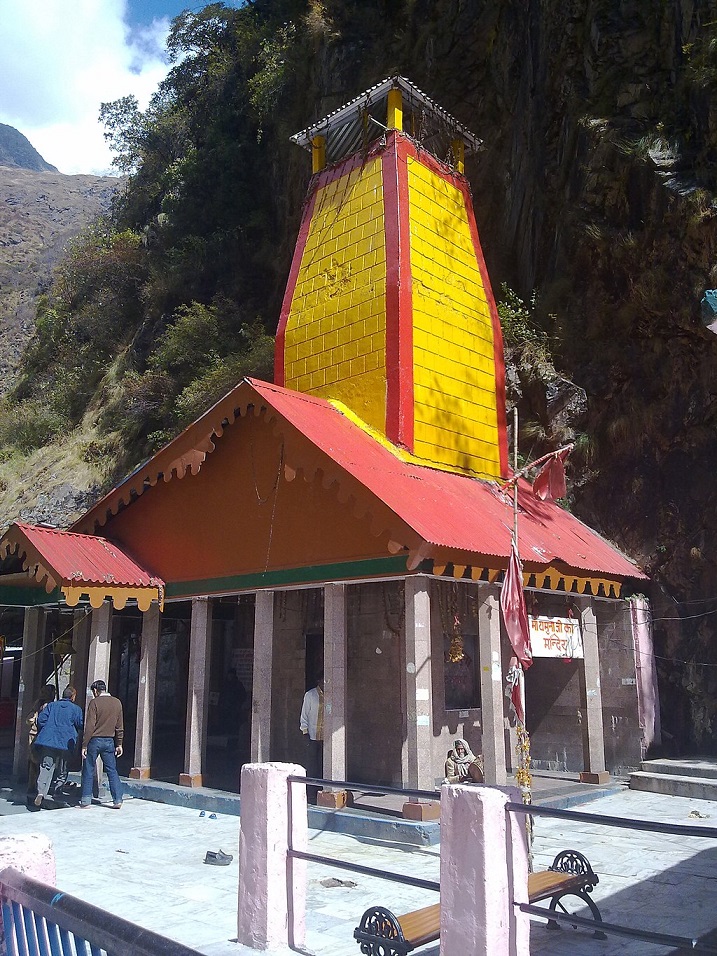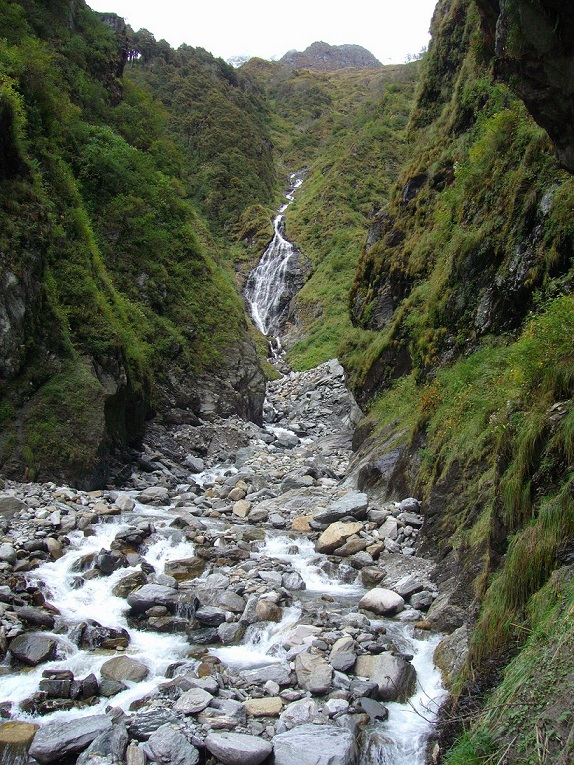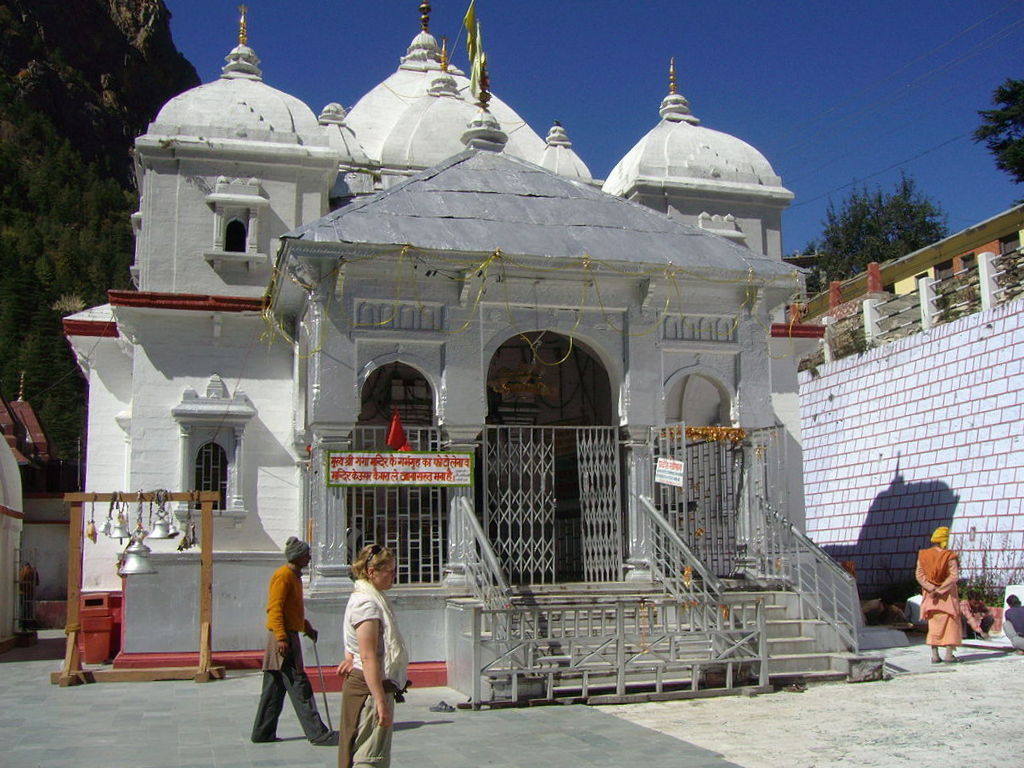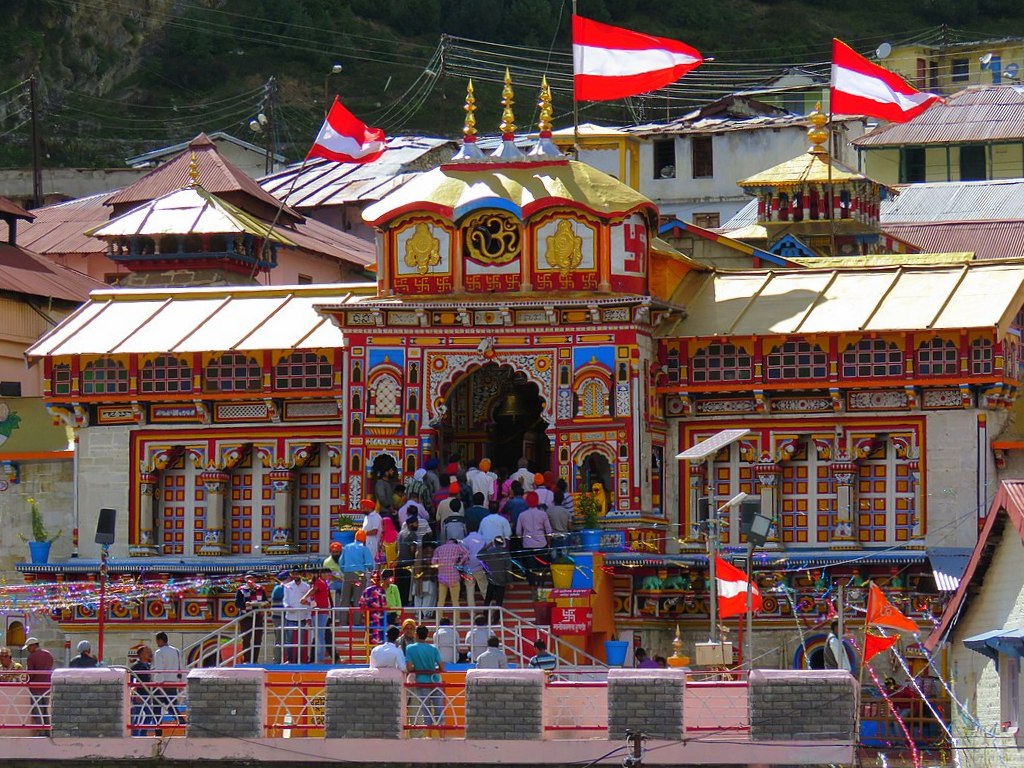
Uttarakhand, a state in northern India crossed by the Himalayas, boasts many holy places and welcomes devotees throughout the year. One of the most prominent religious circuits in Uttarakhand that devotees embark on is the Char Dham (4 Dham) Yatra. This pilgrimage involves visiting four revered sites – Yamunotri, Gangotri, Kedarnath, and Badrinath – nestled in the Himalayas. The term ‘char’ denotes four, and ‘dham’ signifies religious destinations in Hindi. Sometimes this pilgrimage is also referred to as ‘Chota Char Dham yatra’ or smaller 4 Dham yatra.
The high-altitude shrines remain closed for about six months each year, opening in summers (April or May) and closing with the onset of winter (October or November). The Char Dham Yatra is traditionally undertaken in a clockwise direction, beginning from Yamunotri and moving on to Gangotri, Kedarnath, and finally concluding at Badrinath. One can reach these sites by road or air (helicopter services are available). Some pilgrims also undertake a Do Dham (2 Dham) Yatra, which involves visiting two shrines – Kedarnath and Badrinath. Yamunotri temple, situated in a narrow gorge near the source of River Yamuna in the Uttarkashi district, is dedicated to the sacred personality of Yamuna, who is worshiped by devotees. The district of Uttarkashi is also home to Gangotri, dedicated to Goddess Ganga, India’s most sacred river. Kedarnath, located in the Rudraprayag district, is dedicated to Lord Shiva. Badrinath, home to the sacred Badrinarayan Temple, is dedicated to Lord Vishnu, the Supreme Lord. Undertaking the Char Dham Yatra is a challenging yet spiritual journey that provides nourishment to one’s soul.
Yamunotri
Yamunotri is a site of the Char Dham pilgrimage and is located in Uttarkashi district at a height of 3293 mts above sea level. It offers peace and tranquility to visitors and is surrounded by mountains on all sides. The Bandarpunch Mountain lies north of Yamunotri. It is located at a distance of 236 km from Rishikesh, 21 km from Sanya Chatti, 278 km from Dehradun, and 176 km from Chamba. The Uttarakhand Govt has approved the construction of a 3.3 km long ropeway between Kharsali and Yamunotri that will reduce the traveling time to 15 minutes and have a carrying capacity of 500 pilgrims per hour.

Saptarishi Kund, the glacial lake that is the actual source of the Yamuna, is situated at an even higher altitude of 4,421 meters, and can be reached only after a challenging trek to the base of Kalinda Parvat, requiring a guide and a day of acclimatization at Yamunotri. The climb to Saptarishi Kund involves traversing snow and ice. Along the way, visitors pass by the confluence of the Yamuna and Nil Ganga, known as Shani Prayag, where a temple dedicated to Lord Shani is located. The Yamuna River flows from west to east at Yamunotri.
The Yamunotri temple, built in 1839, honors the goddess Yamuna who was born from the union of Surya and Sangya. Yamuna’s black stone statue is housed in the temple alongside the white statue of Gangadevi. Legend has it that bathing in Yamuna’s waters can prevent a painful death. To pay respects to Yamuna, visitors are expected to first visit the Divya Shila located adjacent to the temple. According to the story, Yamuna was born from Surya and Sangya. Sangya would close her eyes when the bright Sun approached her, which angered Surya. As a result, he cursed her that her son would cause fear and take the lives of living beings. This son would be called Yamaraj. However, after seeing Sangya’s repentance, Surya blessed her that she would bear a daughter named Yamuna (also known as Kalindi) who would not only free people from the fear of Yamaraj but also release them from the cycle of birth and death. The temple is located at the foot of Kalinda Parvata and operates from late April to early November.

The true source of the Yamuna, is located at the challenging-to-reach Saptarishi Kund, which requires a guide to navigate. According to legend, the seven great rishis performed rigorous penance here for millions of years in Satya-yuga. To get to Saptrishi Kund, one must undertake a challenging trek spanning 7 kilometers from Yamunotri. This glacial lake measures half a kilometer in length and is encircled by rocky glaciers. Due to its arduous accessibility, very few people visit this remote location.
Gangotri
Here is the tale of how River Ganga descended from the heavens to the earth and became revered. Sagara was a wise king who had 60,000 brave and strong sons. He was the Emperor of the World and performed one hundred great sacrifices to be accepted as such. During his final sacrifice, he set a horse free to roam the world for a year. If other kings captured it, they would declare war against him. However, Indra, the king of the gods, stole the horse to prevent Sagara from taking over heaven. Sagara’s sons found the horse at Kapila’s ashram and, thinking he was the thief, attacked him, resulting in their death. Simply by looking at Sagara’s sons, Kapila Muni burnt them to ashes. Later, one of Sagara’s grandsons found the horse and took it back to his grandfather, who completed the one-hundredth sacrifice.

Many years later, Bhagiratha, Sagara’s great-grandson, asked Kapila how he could help his ancestors ascend to heaven. Kapila suggested that the River Ganga could purify their ashes. The water of the River Ganga is holy because Lord Vishnu’s toe cracked the wall of the universe, and some water entered, which became the River Ganga. In ancient times, Lord Vishnu had appeared as the Vamana avatar and with just three strides, he encompassed the entire universe. As he took his final step, his toe punctured the wall of the universe, causing water to gush in and form the River Ganga, which flowed in heaven. Since the water had touched Vishnu’s foot, it was considered sacred.
Following Bhagiratha’s prayers, Lord Vishnu asked the River Ganga to descend to earth, but she was too ferocious. Lord Shiva held out his matted hair to catch her as she fell, softening her descent to earth. The River Ganga flowed across India, and Bhagiratha led it. One of the streams washed the ashes of the dead princes (ancestors of Bhagiratha), and their souls went to heaven. The River Ganga still flows in India and is considered holy by Hindus. They bathe in her waters for purification and liberation. She is also known as Bhagirathi as Bhagiratha caused her descent to earth from the heavens.

Situated at an elevation of 3,100 meters, Gangotri Temple is the highest temple devoted to Goddess Ganga and is among the four sacred Chota Char Dham Yatra pilgrimage sites in Uttarakhand. Goddess Ganga is venerated as the embodiment of the revered Ganga River. The serene and pristine white temple is surrounded by Deodar and Pine trees and the magnificent Greater Himalayan Range. The holy Bhagirathi River, which is one of the two primary headstreams of Ganga, flows adjacent to the Gangotri Temple. The source of the River Ganga is located at the base of the Gangotri glacier, where it is known as ‘Bhagirathi’. Legend has it that the Gangotri Temple is approximately 200 years old. The temple was constructed in the 18th century by the Gorkha commander Amar Singh Thapa and was later reconstructed by the King of Jaipur. The temple’s Nagara style of architecture is made of white marble stone and features exquisite carvings, with five small pinnacles towering 20 feet high. The principal sanctum or Garbha Griha is erected on an elevated platform. The deities of Goddess Ganga, Yamuna, Annapurna, Saraswati, and Lakshmi are worshiped with great reverence. Additionally, the inner sanctum houses the deities of Bhagiratha and Adi Shankara. Near the Gangotri Temple lies a natural Shiva Linga that is submerged underwater. According to legends, Lord Shiva sat here and divided the Ganga River into seven streams to control her flow. The vicinity of Gangotri Temple includes ‘Bhagirath Sila,’ the spot where King Bhagirath prayed to Lord Shiva to bear the descent of the Ganges. This area holds great significance for devotees who collect water from here to take back to their homes. After the Mahabharata war, the Pandavas performed the ‘Deva Yagna’ at Gangotri to atone for the loss of their loved ones and people.
Badrinath
Badrinath, a significant place of pilgrimage, is regarded as the abode of the Nara Narayana sages, and Srimad Bhagavatam indicates that saintly people, such as Uddhava, have been visiting the place for thousands of years. It is one of the eight self-manifested holy tirthas of India. Badrinath, Rameshwaram, Jagannath Puri, and Dwarka represent the planets of the spiritual sky, consisting of the brahmajyoti and the Vaikuntha. Devotees visit all these holy places for spiritual perfection. Badrinath is particularly dear to Lord Krishna, and the name “Badrinath” comes from the Ilandai tree, which is beloved by Maha-Lakshmi.

According to Srimad Bhagavatam (3.4.22), “There in Badrikashram, the Personality of Godhead, in his incarnation as the sages Nara and Narayana, had been undergoing great penance since time immemorial for the welfare of all living entities.” Skanda Purana proclaims, “There are several sacred shrines in heaven, on earth, and in hell; but there is no shrine like Badrinath.” Badrinath is also known as “Narada Kshetram” because Narada Muni attained liberation here in just five days. Gautama Rishi, Kapila, and Kasyapa are said to have visited, and Sankaracharya established a temple here. Sankaracharya, Ramanujacharya, and Madhvacharya all visited Badrinath in the past.
The Badrinath temple can be found perched at an elevation of roughly 3415 meters above sea level in the Chamoli District of Uttarakhand. The temple sits within the serene valley of Garhwal Himalayas, nestled on the banks of the flowing Alaknanda river. The temple is dedicated to Lord Badrinath and the murti of the deity is self-manifested from a black shaligram-shila, which is 213m (2 ft) high. The temple is adorned with ancient stone carvings, and visitors must cross the Alakananda River and climb up steps to reach it. Lord Badrinath is depicted meditating in the padmasana, with Uddhava to his right, Nara and Narayana on the far right, Narada Muni kneeling in front of the right side, Kubera and a silver Ganesh on the left side, and Garuda kneeling in front to the left of Badrinarayana. The temple also has a separate shrine dedicated to Lakshmi Devi and the Gaddi of Adi Sankaracharya.
Story of Badrinath
The temple’s history, according to the Puranas, dates back to the four ages of creation – Satya-yuga, Treta-yuga, Dvapara-yuga, and Kali-yuga. The Lord lived in a visible form in Badarikashrama during Satya-yuga, and sages could see the Lord through the practice of yoga in Treta-yuga. However, in Dvapara-yuga, it became difficult for even the sages and demigods to see the Lord. In response to their prayers, the Lord instructed them to take a divine image of him from under Narada Shila in the Alaknanda and establish it in a temple. Brahma and other gods built the temple, and the deity was worshiped for six months by humans and six months by gods.
The Skanda Purana tells another story of the establishment of the temple. Lord Shankar prophesied that he would come in the form of a saint and install the deity of Sri Badrinath Ji for the good of all people in Kali-yuga. Shankaracharya fulfilled this prophecy by finding the deity in Narada Kund and installing it in the temple. The priests at the temple had replaced the four-armed form of Narayana with a shaligram-shila stone after the robbers had hidden the form of the Lord in the nearby kund. Shankaracharya went to the kund, found the deity of Lord Narayana, and installed it in the temple. However, the fingers on the right hand of the deity were broken. After pulling out two more deities with the same broken fingers, a voice told Shankaracharya that only this broken form would be worshiped in Kali-yuga.
Today, the temple of Lord Badrivishal attracts people of all races, creeds, religions, and communities who come to see the deity of Lord Narayana. The temple’s history and stories associated with it add to its significance, making it an important pilgrimage site in India.
Kedarnath
The Kedarnath Temple, dedicated to Lord Shiva, is situated on the bank of the Mandakini River between Gangotri and Badrinath. Located at a height of 3584 meters above sea level, Kedarnath is surrounded by awe-inspiring snow-clad peaks, earning its status as the most secluded site of all four Char Dham Shrines. The region has been historically referred to as “Kedar Khand”. The temple was originally built by the Pandavas to atone for sins accrued during the Kurukshetra war and was reconstructed by Shankaracharya in the 8th century. It is considered one of the major Shiva temples in India and one of the 12 Shiva-Jyotirlingas. Over 100,000 pilgrims visit the temple each year.

The temple features an irregular, three-faced linga representing the hump of Lord Shiva in the form of a bull. There are deities of goddess Parvati and Ganesh in front of the main altar door, and outside the second door are Lord Krishna, the five Pandavas, their wife, Draupadi, and their mother, Kunti. The temple faces south, which is a unique feature, and is situated at the end of a lane surrounded by small hotels and restaurants. The Kedarnath Temple is open to the public from the first week of May until either the last week of October or the first week of November. The busiest time of the year is during May and June. During the winter, worship is conducted in the village of Okhimath by the priest from the Kedarnath Temple.
Story of Kedarnath
After the Battle of Kurukshetra, the Pandavas sought Lord Shiva in Kasi to seek atonement for the sin of killing their kinsmen in battle. However, Lord Shiva playfully avoided them by disguising himself first as a brahmana in Gupta Kasi and then as a bull in a valley in the Himalayas. Bhima, one of the Pandavas, recognized Lord Shiva as the bull and caught him by the tail. Lord Shiva then decided to give them his audience and instructed the Pandavas to worship the hump of the bull, which led to the establishment of the Kedarnath temple. The Pandavas also built temples in other mountains where other parts of Lord Shiva’s body had appeared, known as PanchKedars: Kedarnath for the hump, Tungnath for the arm, Rudranath for the face, Kalpeshwar for the hair, and Madhyamaheshwar for the navel.
Picture attributions :
JediPro, CC BY-SA 3.0 via Wikimedia Commons
Atarax42, CC BY-SA 3.0 via Wikimedia Commons
Atarax42, CC BY-SA 3.0 via Wikimedia Commons
Dhwani Shree, CC BY-SA 4.0 via Wikimedia Commons
Shitha Valsan, CC BY-SA 4.0 via Wikimedia Commons
Atarax42, CC BY-SA 3.0 via Wikimedia Commons